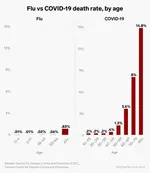charmedbyekkie
New member
Re: Wuhan virus
Found a really good breakdown of the WHO findings from their study of China during this time here.
Some quick highlights of this already highlighted findings:
Found a really good breakdown of the WHO findings from their study of China during this time here.
Some quick highlights of this already highlighted findings:
When a cluster of several infected people occurred in China, it was most often (78-85%) caused by an infection within the family by droplets and other carriers of infection in close contact with an infected person. Transmission by fine aerosols in the air over long distances is not one of the main causes of spread. Most of the 2,055 infected hospital workers were either infected at home or in the early phase of the outbreak in Wuhan when hospital safeguards were not raised yet.
The most common symptoms are fever (88%) and dry cough (68%). Exhaustion (38%), expectoration of mucus when coughing (33%), shortness of breath (18%), sore throat (14%), headaches (14%), muscle aches (14%), chills (11%) are also common. Less frequent are nausea and vomiting (5%), stuffy nose (5%) and diarrhoea (4%). Running nose is not a symptom of Covid.
An examination of 44,672 infected people in China showed a fatality rate of 3.4%. Fatality is strongly influenced by age, pre-existing conditions, gender, and especially the response of the health care system. All fatality figures reflect the state of affairs in China up to 17 February, and everything could be quite different in the future elsewhere.... China also tested various treatment methods for the unknown disease and the most successful ones were implemented nationwide. Thanks to this response, the fatality rate in China is now lower than a month ago.
Gender: Women catch the disease just as often as men. But only 2.8% of Chinese women who were infected died from the disease, while 4.7% of the infected men died.
The new virus is genetically 96% identical to a known coronavirus in bats and 86-92% identical to a coronavirus in pangolin. Therefore, the transmission of a mutated virus from animals to humans is the most likely cause of the appearance of the new virus.
Since the end of January, the number of new coronavirus diagnoses in China has been steadily declining (shown here as a graph) with now only 329 new diagnoses within the last day - one month ago it was around 3,000 a day. "This decline in COVID-19 cases across China is real," the report says. The authors conclude this from their own experience on site, declining hospital visits in the affected regions, the increasing number of unoccupied hospital beds, and the problems of Chinese scientists to recruit enough newly infected for the clinical studies of the numerous drug trials. Here is the relevant part of the press conference about the decline assessment.
One of the important reasons for containing the outbreak is that China is interviewing all infected people nationwide about their contact persons and then tests those. There are 1,800 teams in Wuhan to do this, each with at least 5 people. But the effort outside of Wuhan is also big. In Shenzhen, for example, the infected named 2,842 contact persons, all of whom were found, testing is now completed for 2,240, and 2.8% of those had contracted the virus. In Sichuan province, 25,493 contact persons were named, 25,347 (99%) were found, 23,178 have already been examined and 0.9% of them were infected. In the province of Guangdong, 9,939 contacts were named, all found, 7,765 are already examined and 4.8% of them were infected. That means: If you have direct personal contact with an infected person, the probability of infection is between 1% and 5%.
"China’s bold approach to contain the rapid spread of this new respiratory pathogen has changed the course of a rapidly escalating and deadly epidemic. In the face of a previously unknown virus, China has rolled out perhaps the most ambitious, agile and aggressive disease containment effort in history. China’s uncompromising and rigorous use of non-pharmaceutical measures to contain transmission of the COVID-19 virus in multiple settings provides vital lessons for the global response. This rather unique and unprecedented public health response in China reversed the escalating cases in both Hubei, where there has been widespread community transmission, and in the importation provinces, where family clusters appear to have driven the outbreak."
"Much of the global community is not yet ready, in mindset and materially, to implement the measures that have been employed to contain COVID-19 in China. These are the only measures that are currently proven to interrupt or minimize transmission chains in humans. Fundamental to these measures is extremely proactive surveillance to immediately detect cases, very rapid diagnosis and immediate case isolation, rigorous tracking and quarantine of close contacts, and an exceptionally high degree of population understanding and acceptance of these measures."


